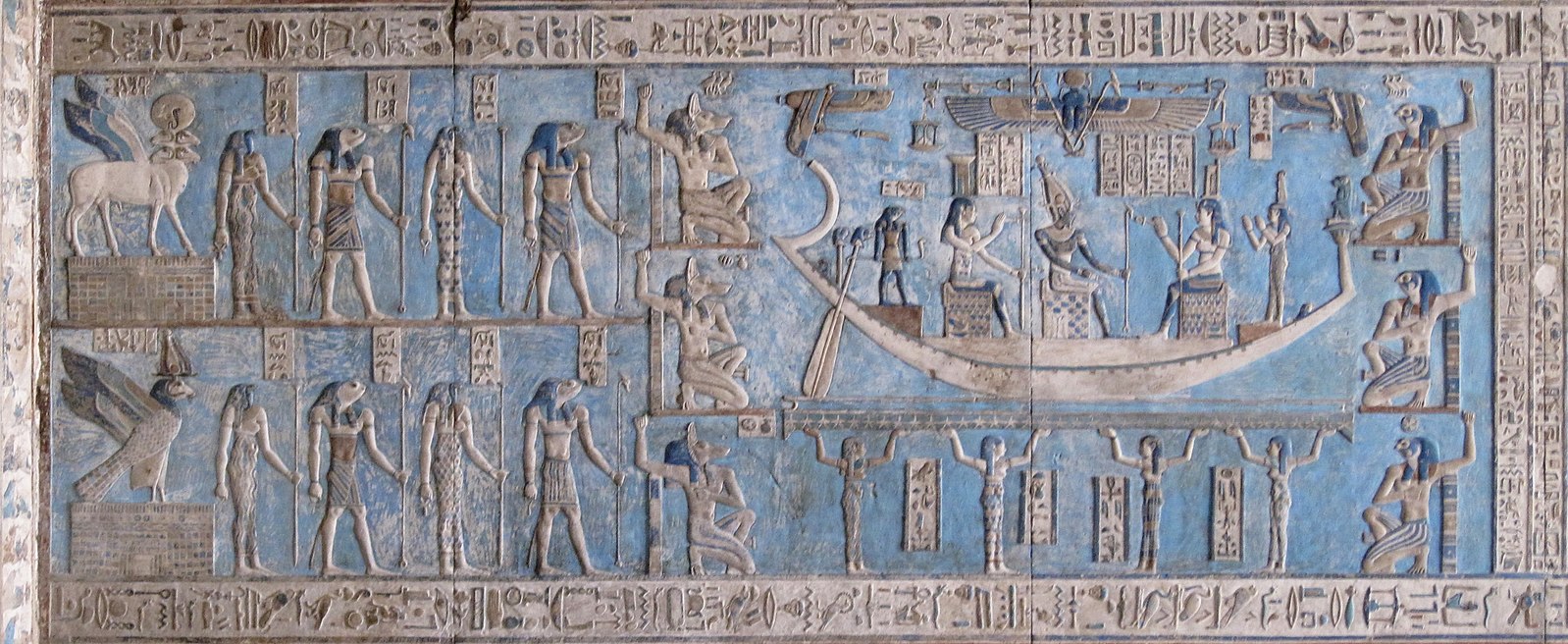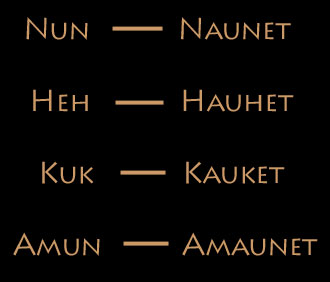Hermopolis means “the city of Hermes” in Greek. The Greeks gave it that name because it was a major cult centre of the god Thoth whom they associated with their god Hermes, but the Egyptians knew it as Khmunu (“the City of the Eight”).

The Ogdoad was a system of eight deities, four gods and their consorts (the number four was considered to represent completeness). Each pair represented the male and female aspects of the four creative powers or sources. Nun and Naunet represented the primeval waters; Heh and Hauhet represented eternity; Kuk and Kauket represented darkness; and Amun and Amunet represented air (or that which is hidden). However, the gods differ from one source to another.

Primeval darkness was sometimes represented by Gereh and Gerehet, and Heh and Hehet are sometimes included as forces of chaos, possibly representing the currents of the primeval waters. When Amun rose in prominence as a creator god in his own right, he and Amunet were replaced by Nia and Niat, gods of the void.
The gods were often depicted with frog’s heads, while the goddesses had the heads of serpents. Only Amun went on to be considered as more than a primeval force. While Nun was still referred to often, it was only as the representation of the waters of Chaos.
These eight elements interacted causing an explosion (the Big Bang?) and the burst of energy which was released caused the primeval mound (located at Hermopolis, but originally known as the “Isle of Flame”) to rise from the water. It was thought The gods and goddesses of the Ogdoad then ruled the earth during the Golden Age. When they died they took up residence in the “Duat” (or “Tuat” – the Underworld). They ensured that the Nile continued to flow, that the inundation would come every year and caused the sun to rise each day.

There are four central creation myths. The first held that the world was born from a cosmic egg created by the gods of the Ogdoad. It was invisible as the sun had not yet been born. When it opened, it revealed the “bird of light”, an aspect of the sun god Re (occasionally the egg was said to contain air, associated with Amun and Amaunet).
Alternatively, the egg was laid by a celestial goose called the Gengen Wer (the primeval goose who was associated with Amun who took this form as a creator god). When Re hatched from the egg, he created the world and everything in it.
The second version says that the egg was laid by an ibis, (a bird sacred to Thoth). However, the cult of Thoth developed after the original myth of the Ogdoad, so it is probable that this story was an attempt to incorporate Thoth into the pre-existing Ogdoad (who were sometimes known as “the souls of Thoth” or the “Eastern Souls”, eight baboons who helped the sun to rise every morning).
The third myth states that a lotus flower emerged from the waters of “the Sea of the Two Knives” (a lake near to the temple in Hermopolis). The petals opened to reveal Re who then created the world.
The fourth myth is similar, except it held that a scarab beetle (Khepri – the symbol of the rising sun) was revealed when the petals opened. The scarab transformed into a young boy whose tears formed the first human beings. The boy is generally considered to be Nefertum (“young Atum“) but once Re and Horus had been merged as Re-Horakhty the boy was sometimes considered to be the infant Horus.
The Hermopolitans claimed that their theory of creation was older than any other in Egypt and that it was the Ogdoad who gave birth to both the sun and Atum. It is interesting to note the similarity between the Ogdoad and the description of the creation of the world found in the Pentateuch (the first five books of the Old Testament).
Bibliography
- Budge, E Wallis (1904) The Gods of the Egyptians
- Goodenough, Simon (1997) Egyptian Mythology
- Pinch, Geraldine (2002) Handbook Egyptian Mythology
- Watterson, Barbara (1996) Gods of Ancient Egypt
- Wilkinson, Richard H. (2003) The Complete Gods and Goddesses of Ancient Egypt
- Wilson, Hilary (1997) People of the Pharaohs
Copyright J Hill 2016